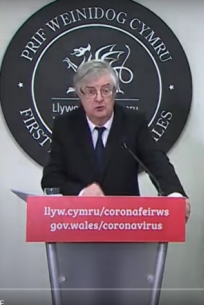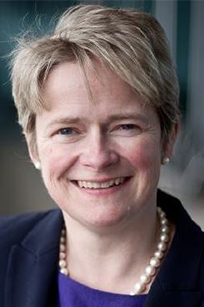Covid-19 update: 19 February
The latest findings from the React 1 study (Real-time Assessment of Community Transmission) were published on Thursday. The study, which tests a random sample of people each month to determine current levels of coronavirus infection, revealed that the numbers infected have fallen by over two-thirds since January. However, infections remain high with one in 200 testing positive.
There are regional differences with the Yorkshire and Humber region seeing infections fall by just a quarter, while in London and the South East there are now five times fewer people testing positive. The prevalence of the infection has also dropped across all ages at a similar rate, suggesting that the downward trends are due to lockdown rather than the impact of vaccination.
Paul Elliott, director of the programme at Imperial College London, which is running the study with Ipsos Mori, said it was encouraging that lockdown measures were bringing infections down. ‘It’s reassuring that the reduction in numbers of infections occurred in all ages and in most regions across the country,’ he said. The interim findings of this ninth report from the study are based on 85,000 volunteers. Next week’s full report will be based on almost double this number.
On the basis of the results, researchers estimated the national R number – the average number of secondary infections produced by a single infected person – to be 0.72. Anything below 1 means virus infections are shrinking.
The decline of the virus can also be seen in the government’s Covid-19 dashboard, which shows a seven-day average rate of just over 12,000 positive cases a day, down from a peak of nearly 60,000 in early January and a 36% fall over the last fortnight.
The vaccination programme offered more good news with the achievement of its first target – to offer a vaccine to the 15 million people who make up all over-70s, the clinically extremely vulnerable, care home residents and NHS and care staff. Prime minister Boris Johnson said on Monday that the programme ‘continues to power past’ this target, but added that it was a time to accelerate the programme, not relax.
He pointed out that while 90% of those aged 70 or over had been vaccinated, 60% of Covid patients in hospital were under 70. And there was still limited data about the exact effectiveness of the vaccines in reducing the spread of infection.
Figures released for England show that 2.6 million people aged 80 or over had received a first dose by 14 February, 93% of the estimated population for that age group. The 4.5 million people vaccinated in the 70 and over category represent 95% of that community. For care home residents the percentage was nearly 95% (although residents who have tested positive for Covid-19 in the last 28 days are excluded from these figures), while for care home staff it was 69%. Figures released in Northern Ireland were similar for the 80-year-olds and over (94%) but lower for the younger ages at 88% (75-79) and 75% (70-74).
Take-up concerns
However, it was also reported that a third of social care staff in England had not had the vaccine, despite being in one of the top four priority groups. A study at the University Hospitals of Leicester NHS Trust also raised concerns about take-up of the vaccine among black, Asian and minority ethnic (BAME) staff. A pre-review report of the study, which does not reflect the most up-to-date picture, found that doctors at the trust had the lowest vaccination rate (57%), compared with 63% for nurses and 73% for administrative and executive staff. However, while 71% of white healthcare workers had taken up the vaccine, the figures were lower for Asian (59%) and black (37%) staff members.
Northern Ireland further extended its vaccination programme this week to include carers, more people with underlying health conditions, and those aged 60 and over, enabling more people to book a jab at a regional centre rather than waiting for their GP to contact them. Anyone aged 70 plus who had not yet had their vaccination was also given the option of booking with the regional centres.
Scotland first minister Nicola Sturgeon declared herself ‘satisfied’ that the 15 February vaccination target had been met. She also said there was ‘compelling evidence now that vaccination is starting to work to reduce the number of people dying’. She pointed to a 62% reduction in the number of Covid deaths in care homes over the past three weeks – a larger decline than deaths in hospitals or in people’s own homes. And deaths occurring in care homes as a proportion of all Covid deaths was now lower than at any time during the pandemic.
There have already been announcements about eased restrictions across the UK. In Wales, it was announced earlier this month that a phased return to face-to-face learning would start on 22 February for the very youngest children.
And on Friday Wales first minister Mark Drakeford (pictured) said that getting children back into school remained the Welsh government’s top priority. ‘This means the over-arching stay-at-home measures will need to remain in place for a further three weeks,’ he said. However, a few modest changes were announced, including allowing up to four people from two different households to exercise outdoors together. He clarified this did not mean being able to drive to take exercise and it was only for exercising, not socialising. Weddings and civil partnerships will also be allowed from next week, with venues able to open to perform ceremonies.
Scotland is also starting the process of getting pupils back to school from Monday but is set to publish its own broader plans for coming out of lockdown next week – expected soon after Mr Johnson’s Monday announcement.
Despite virus infections moving in the right direction and continuing good progress with vaccinations, health leaders are urging caution ahead of next week’s announcement of a roadmap out of lockdown. The impact of Covid on NHS services was clear in performance figures for Wales which showed nearly 539,000 people now waiting for non-urgent hospital treatment. This is a record high with more than 82,000 people added to the list since March last year. And the numbers waiting more than 36 weeks stood at more than 226,000 in December, almost nine times higher than a year before.
A spokesperson from the Welsh NHS Confederation said the figures showed the scale of the challenge the NHS is facing. ‘This winter has been the most difficult in the NHS’s history, with critical care capacity running well above pre-pandemic levels and staff absence rates high,’ they said. ‘This coupled with the rollout of the biggest vaccination programme the NHS has ever carried out has resulted in incredibly stretched resources.’
Four tests
Back in England, in a letter to the prime minister, NHS Providers insisted that four tests must be passed before current restrictions are relaxed.
First, Covid cases and the R number ‘must drop significantly’ to protect against infections simply bouncing back up. NHS capacity would also need to return to a level where the service can treat all patients it needs to. The vaccination campaign should be sufficiently advanced and there must be a robust strategy in place to rapidly identify future outbreaks from variant strains.
‘The evidence on Covid-19 cases, NHS capacity, progress with vaccinations and readiness to combat Covid-19 variants all show that it is much too early to start lifting restrictions,’ said the organisation’s chief executive Chris Hopson. ‘Covid-19 case numbers are still far too high. The NHS is still at full stretch and trust leaders believe this will continue for at least another six to eight weeks.’
In a more detailed briefing for MPs, the representative body said it understood the need to protect the economy, but easing restrictions too soon could be a backwards step. ‘A healthy economy depends on a healthy public and bouncing in-and-out of repeated lockdowns, due to premature relaxation of restrictions, risks doing more long harm to the economy than taking a more cautious approach,’ it said.
It did not set precise thresholds for each test, suggesting the government, with access to the necessary evidence and data, was best placed to do this. However, it stressed the importance of having a highly capable test and trace systems ‘which can genomically sequence very large numbers of tests in a matter of two to three days to identify the presence and potential spread of any new variant’. While NHS Test and Trace had made significant progress increasing capacity and capability, it was not yet at the stage to be able to do this, it said.
Independent Sage, the unofficial scientific advisory body, warned a sustainable suppression strategy was needed to avoid future lockdowns. It said that vaccination alone won’t be enough to keep infection rates down without a functioning test, trace and supported isolation system. This system should be ‘rooted in local communities and organised through local public health bodies’. Its strategy has five pillars, including strict border controls and vaccination for the whole population, and calls for incidence to be below 100 confirmed cases per 100,000 population in all regions before restrictions are lifted.
Tracing improvements
Interim executive chair of the National Institute for Health Protection Dido Harding (pictured) said the English test and trace service was working non-stop to combat the spread of the virus. ‘NHS Test and Trace has maintained a strong start to the year and is delivering consistent outputs to ensure the service continues to reach a high proportion of cases and contacts quickly and conveniently,’ she added. ‘The continued development of the service has been crucial to achieving this.’
Ministers pointed to the latest week’s results with 87% of positive cases reached along with 94% of their contacts, leading to 271,000 people being asked to self-isolate. As always the detail of the statistics is needed to understand the headline numbers. The full figures for the week to 10 February show that 87% of the 106,000 cases transferred to the service were indeed reached – but that means that nearly 14,000 people who tested positive were not contacted.
Of the 92,000 that were reached, just over 68,000 (74%) provided details of one or more close contacts. That means that 24,000 people either had had no recent close contacts or could not provide details of those contacts. The 68,000 that did provide contact details offered up 191,000 contacts and it is 94% of these contacts who were reached by the service.
Comparisons with performance last year also need to be handled carefully as the service no longer contact traces individual members of a household separately – so effectively contacting one member of the household counts as contacting all of them.
The service is clearly producing much better results, but it is important to recognise the potential leakage at each stage of the process rather than just looking at the headlines.
NHS Providers’ Mr Hopson said the encouraging trend had to continue. ‘It is reassuring that a very high proportion of positive cases recorded each week are being transferred into the tracing system, but one in eight of these is not being reached and asked to provide details of their contacts, which means there is still more work to do,’ he added. ‘There has undoubtedly been progress, but it remains imperative to identify as many close contacts as possible. It is vital that we have a robust Test and Trace service to stay on top of the current caseload, as well as to quickly identify and control future outbreaks from variant strains.’
All eyes now turn to next week and the government’s announcement of the next steps and timetable for moving out of lockdown.
Related content
We are excited to bring you a fun packed Eastern Branch Conference in 2025 over three days.
This event is for those that will benefit from an overview of costing in the NHS or those new to costing and will cover why we cost and the processes.